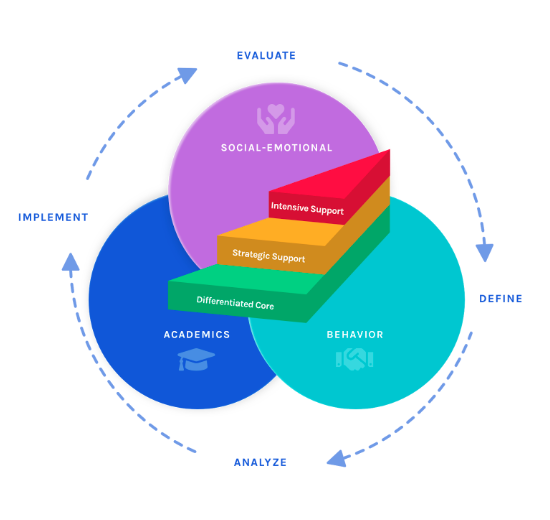
A three-tiered system of service delivery is a necessary structure to efficiently and effectively support all children, not just those who struggle in school. The three-tiered system of service delivery is crucial in the attempt to ensure all students achieve at high levels and all students achieve college and career readiness.
The 1st step in building an RTI/MTSS system involves examining system effectiveness, which must occur prior to examining students individually. This section describes each tier in detail, and how to examine the effectiveness of a school’s system of service delivery.
Tier 1 Core Instruction:
At Tier 1, all students receive scientific, research-based core instruction implemented with integrity and emphasizing grade-level standards and school-wide behavioral expectations. Instruction at Tier 1 should be explicit, differentiated, and include flexible grouping and active student engagement. To check on the fidelity of core instruction, universal screening assessment data should show that at least 80% of students are reaching benchmark goals with only core instruction support. 100% of students receive support at Tier 1, with students requiring additional support to reach their benchmark receiving interventions with Tier 2 and Tier 3 support.
Features of high quality, research-based instruction include (Chard et al., 2008):
-
Standards-Based Curriculum: a curriculum based upon the TEKS/Common Core State Standards (or district standards).
-
Systematic Explicit Instruction: Skills are taught from less to more complex using direct, clear, and concise instructional language.
-
Differentiated Instruction: Students have different levels of background knowledge and school readiness; differentiated instruction engages each student in active learning according to his/her needs. The content of instruction, delivery of instruction, and targeted level of instruction can be differentiated.
-
Flexible Grouping: A combination of the whole group, small group, and individual instruction allows teachers to create fluid groups that meet the needs of all students.
-
Active Student Engagement: Ensuring all students are actively involved during instruction and are not passive recipients; this can be accomplished with high rates of opportunities to respond, ample time to practice skills, and prompt corrective feedback.
-
Classroom Behavior Strategies: Proactively and explicitly teaching the expected behaviors and routines, frequent use of reinforcement and praise (4:1 positive to negative feedback loop), quick and efficient transition times, and consistent instructional response to misbehavior.
A solid Tier 1 should be sufficient to help 80% of students meet or exceed grade-level expectations as measured by a standardized summative assessment. If Tier 1 instruction is not successful in meeting the needs of at least 80% of the school’s population, the school team should evaluate the quality of the curriculum and its delivery and also consider possible solutions to create a better match between students’ needs and the core curriculum and instruction (e.g., improving explicit instruction, differentiation strategies, use of flexible grouping, and maximizing active student engagement).
Tier 1 Enrichment and Support
Students who are meeting or exceeding standards may require enrichment beyond the core to demonstrate academic growth. It is the school’s responsibility to ensure that all students make academic progress regardless of their entry level. The Branching Minds Support Library contains tier 1 learning activities that may be used as teachers design differentiated instruction for individual or small groups of students.
Check out this blog: What is tier 1 in RTI/MTSS?
Tier 2 Targeted Group Intervention
At Tier 2, students identified as being at-risk academically or behaviorally through universal screeners are provided scientific, research-based interventions in addition to the core. Approximately 10-15% of students will need supplemental instruction at Tier 2 to become proficient. Tier 2 interventions are implemented with groups of students demonstrating common skill deficits or social/emotional/behavioral risk characteristics. These students should be observed on Branching Minds, where a collaborative intervention plan is developed, monitored, and documented.
Targeted group interventions typically involve an additional 60-90 minutes of instruction (outside of core instruction) provided each week (e.g., two to three 30-minute intervention periods). Targeted group interventions must be more explicit: more intensive than core instruction; more supportive in the form of encouragement, feedback, and positive reinforcement; carefully scaffolded; and ideally occur in groups of approximately 3 to 5 students, for elementary, and 6 to 8 students or larger groups broken into a few groups of 6 to 8 students, for middle and high schools.
Check out this blog: What is tier 2 in RTI/MTSS?
Tier 3 Intensive Individualized Intervention
Students who have not demonstrated progress with targeted group interventions at Tier 2 require more time in more intensive interventions. Tier 3 interventions are distinguished from Tier 2 interventions because they are individualized based on data collected in individual problem solving, occur with smaller student-teacher ratios (e.g., ideally 1-on-1, however, groups of 3 to 5 students or a larger group broken into a few groups of 3-5 students, is acceptable for middle and high schools), and possibly occur for a longer duration of time (e.g., more daily minutes or more weeks spent in intervention). About 5-10% of students will require this level of intensive support.
Tier 3 intervention plans include more than what occurs during intervention time. They also include strategies for maximizing student outcomes during core instruction or Tier 1, as well as supports to use at home or in the community.
Check out this blog: What is tier 3 in RTI/MTSS?
Branching Minds supports all tier levels
About the author
Branching Minds
Branching Minds is a highly respected K-12 services and technology company that leverages the learning sciences and technology to help districts effectively personalize learning through enhancements to their MTSS/RTI practice. Having worked with hundreds of districts across the country, we bring deep expertise in learning sciences, data management and analysis, software design, coaching, and collaboration. Combined with our extensive toolkit of resources, PD, and technology, we provide a system-level solution. We are more than a service or a software provider, we are partners who will deliver sustainable results for educators, and a path to success for every learner.

Your MTSS Transformation Starts Here
Enhance your MTSS process. Book a Branching Minds demo today.
















.png?width=716&height=522&name=Tier%203%20Behavior%20Support%20Planning%20(preview).png)
